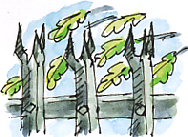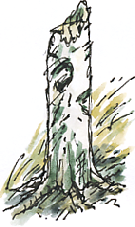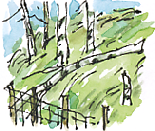previous | home page | this month | e-
Spiked
Richard Bell’s Wild West Yorkshire nature diary, Friday, 5th June 2009
previous | home page | this month| e-



A TALL SPIKED fence around an oak tree; no, of course it’s not what I like to see in the countryside; the iron talons of private interest clawing away another patch of our community’s heritage. But that’s not the whole story, if you see it from the point of view of wild flowers, birds and small mammals.
The fence surrounds one end of an old mineral railway that used to take coal (including, so local tradition has it, house coals to Buckingham Palace when Queen Victoria was in residence) from Hartley Bank Colliery, crossing the canal and the River Calder to coal staithes connecting with road and railway. The colliery and the little railway closed in the late 1960s.
It’s 30 years this spring since I met Barbara and I remember I brought her along this old railway the first time we went on a walk together. It was very much my local patch.
I’ve drawn dozens of sketchbook pages along the old railway over the years of willows,
brambles, birches and of ducks, including pintails, which you’d be lucky to see now,
on the marshy field that it overlooks. I’ve painted a small acrylic of this marshy
field -
Being so broke I’d used the cheapest 2 x 1 inch timber to baton the board so I had
to buy marine ply in Oxford and use the Ruskin School’s workshop to re-
But it sold at the preview!
It’s always a shock to see favourite trees -
We can’t wander along the old railway as we have for the last 30 or 40 years but
that also means that the birds and other wildlife enclosed by the spiked barrier
and stock-
Chainsawing birches at waist level may be the easiest option but it’s probably not
the best forestry practice. However, as the stumps rot they’ll become a habitat for
fungi and insects -